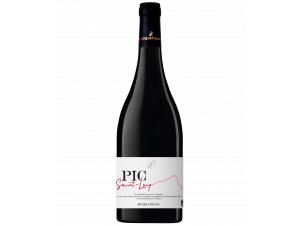You have no items in your shopping cart.
Wine Pic Saint-Loup
-
Top Selling
-
Top Selling
-
Top Selling
- -17%
- -13%
The Pic-Saint-Loup AOC at the heart of the legend
The name of this appellation is a bit peculiar, and has nothing to do with the wine. The name of the appellation always derives first and foremost from the name of the place, and here it comes from a legend dating back to the time of the Crusaders. Three brothers, Thieri, Alban and Guiral Loup are all in love with a beautiful lady called Bertrade. But they all go on a Crusade, waiting for fate to choose which of them will return alive to marry Bertrade. But all three return from their Crusades alive, and it is Bertrade who has died while they were away. In despair, the three brothers leave to live as hermits on the top of three peaks in the region. Thieri was the last brother to die, and the highest peak was named Pic-Saint-Loup in his memory.
The vine developed in the region thanks to the Roman occupation, and wine became one of the most consumed products in France. Vines were already known to give better grapes when planted on chalky hillsides, such as the soils found in this region of Languedoc. With the fall of the Roman Empire, vine cultivation disappeared, but was revived in the Middle Ages, with the monks. There is nothing to report until the revival of the vineyard post phylloxera crisis in the 19th century. At the beginning of the 20th century, Pic-Saint-Loup wine began to be consumed on a national scale, notably on the tables of Parisian bistros. However, it was only in 2017 that the AOC was officially registered and recognised. It is therefore one of the most recently registered AOCs!
In terms of location, the Pic-Saint-Loup appellation extends over 17 communes in the Hérault and the Gard, at the foot of the Cévennes. The total area of the appellation is 5,300 hectares, but only 1,200 are planted. There are 53 estates in this appellation, including 3 cooperatives.
The Pic-Saint-Loup AOC is based on a steep and unusual terroir
The Pic-Saint-Loup appellation region benefits from a unique climate which does not vary according to the vintage: the climate is continental and Mediterranean influenced, the summers are hot and dry, the springs and winters are cool to cold, and very rainy. The soils are therefore very wet compared to other appellations in the region, and it is even the region of the Languedoc where it rains the most. The soils are largely composed of limestone.
The geology of the appellation is particularly mountainous, so the subsoils are very thick, which allows a large number of variety of grapes to adapt to these hard, soft, fluvial or marl limestone soils. This geological diversity therefore allows for both drainage and water retention, which is crucial in the region, as rainfall is not regular at all as we have seen above. This is perhaps what explains the great variety of grape varieties grown in the appellation.
In fact, the wines of this appellation are mostly made from Syrah, Grenache and Mourvèdre. These are the three main grape varieties of the appellation, all three bringing different characteristics to the wines. Grenache, formerly the dominant grape variety in Pic-Saint-Loup, is now supplanted by Syrah. Syrah brings colour and aromas, Grenache ensures structure and ageing. These 3 grape varieties are accompanied by Cinsault and Carignan in a large number of blends. These grape varieties are used to make both reds and rosés. The reds must contain at least 50% Syrah, the rosés at least 30%.
What are the characteristics of Pic-Saint-Loup wines?
Red Pic-Saint-Loup
To the eye, the dress is dark, dense, with purple highlights. On the nose the notes of black fruits (blueberry, blackcurrant), liquorice, violet and spices, representative of Syrah, are sometimes accompanied by notes of red fruits, garrigue, vanilla. If the wine has been aged in barriques, roasted notes of cocoa or coffee may also emerge. These aromas develop on the palate, the texture of the wine is generous, round and full. The tannins are dense, but quite fine. A nice freshness crowns the tasting.Pic-Saint-Loup rosés
The colour of the rosés of the appellation is often quite deep, but of a soft pink. On the nose, the aromas of small red fruits such as strawberry, redcurrant and raspberry are very present, and seconded by more floral, citrus aromas and some spicy touches. On the palate, the combination of Syrah, Grenache and Mourvèdre creates fresh, round and fruity rosés that are particularly pleasing.What dish to enjoy a Pic-Saint-Loup with?
The reds will offer perfect pairings with grilled red meats, or other dishes from the region, such as daubes and civets. Ratatouille is also a great vegetarian pairing with these wines, combining very well with the aromatic herbs of the Languedoc, such as bay leaves, thyme.
Rosés will be the faithful allies of your aperitifs, but will also surprise on pizzas seasoned with oregano and basil, or on squid, squid or grilled fish. White poultry skewered with thyme will go perfectly with these rosés.
The domianes of Pic-Saint-Loup to discover
Château Puech-Haut
This wine is typically the kind of cuvée to which one can attribute the name of nugget. A particularly successful Syrah and Grenache pairing, which will offer you the best of this exceptional terroir.Château De Lascaux
The 85 hectares of vines on this property are surrounded by over 300 hectares of garrigue. The Cavalier family is at the head of this property, which works in organic agriculture. This 80% Syrah and 20% Grenache combination is particularly successful, and embodies the Pic-saint-Loup appellation very well.Banyuls Grand Cru
Clairette-du-Languedoc
Coteaux-du-Languedoc Cabrières
Coteaux-du-Languedoc Grès-de-Montpellier
Coteaux-du-Languedoc La Méjanelle
Coteaux-du-Languedoc Montpeyroux
Coteaux-du-Languedoc Pézenas
Coteaux-du-Languedoc Saint-Drézéry
Coteaux-du-Languedoc Terres de Sommières
Côtes-du-Roussillon Les Aspres
Côtes-du-Roussillon-Villages Caramany
Côtes-du-Roussillon-Villages Latour-de-France
Côtes-du-Roussillon-Villages Lesquerde
IGP Coteaux de Narbonne
Languedoc Grés de Montpellier
Muscat-de-Frontignan
Muscat-de-Mireval
Muscat-de-Saint-Jean-de-Minervois
Pays d'Oc Gewurztraminer
Saint-Chinian Berlou
Saint-Chinian Roquebrun
Vin de Pays Cathare
Vin de Pays de Cassan
Vin de Pays de Caux
Vin de Pays de Cucugnan
Vin de Pays de la Côte Vermeille
Vin de Pays de la Haute Vallée de l'Aude
Vin de Pays de la Vallée du Paradis
Vin de Pays de la Vaunage
Vin de Pays de la Vicomté d'Aumelas
Vin de Pays de Saint-Guilhem le Désert
Vin de Pays des Collines de la Moure
Vin de Pays des Coteaux d'Ensérune
Vin de Pays des Coteaux de Miramont
Vin de Pays des Coteaux de Murviel
Vin de Pays des Coteaux de Peyriac
Vin de Pays des Coteaux du Pont du Gard
Vin de Pays des Coteaux du Salagou
Vin de Pays des Coteaux Flaviens
Vin de Pays des Côtes Catalanes
Vin de Pays des Côtes de Prouilhe
Vin de Pays des Côtes de Thau
Vin de Pays des Côtes de Thongue
Vin de Pays des Côtes du Brian
Vin de Pays des Hauts de Badens
Vin de Pays des Pyrénées-Orientales
Vin de Pays du Mont Baudile
Vin de Pays du Torgan


































 TWIL - Achat de Vin
TWIL - Achat de Vin


